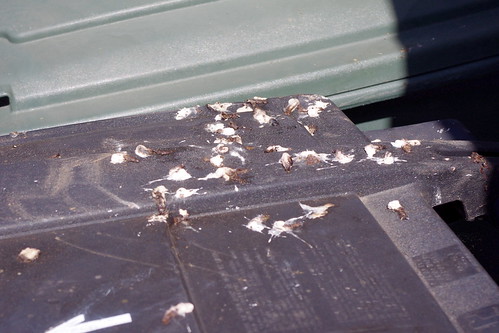 |
| In the words of Oliver Wendell Douglas of Hooterville "What the . . . ?" |
This is what I saw very early every Tuesday morning at Mum's place when taking the garbage out to the curb for Trash Pick up day. At first, I unconsciously assumed some bird/s were using it as a perched, until one day I decided to look up.
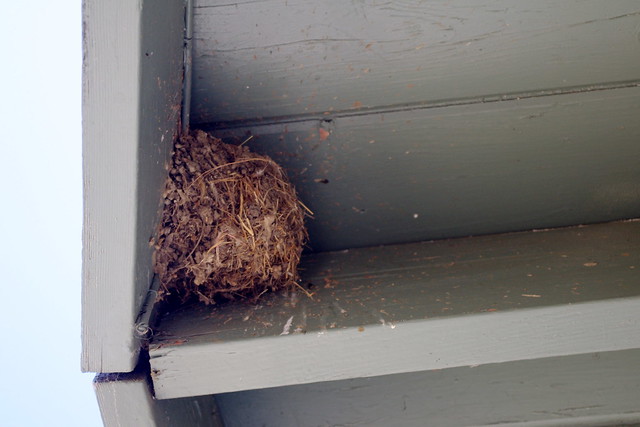 |
| Credit Photo: Mine |
This nest was a surprise to me as I have never really seen this before, although I have been familiar with the builder of it for years both in the wild and in the urban landscape business. This sort of hybrid looking mud & straw Swallow nest on steroids is the home for the Black Phoebe (Sayornis nigricans).Below is a nice 56 second video done by Las Pilitas Nursery owner and Nature educator Bert Wilson. It shows the common Black Phoebe which is a dapper flycatcher in the western U.S.A. They reside near riparian water habitats in the wild, but also known around urban landscapes, especially in and around lawns. You will often see them on a fence post perch next to the lawn, a near by roof top gable or other lookout perch where they incredibly spy out some type of small winged insect in the grass for which you can't even see. They will then suddenly pounce upon the unsuspecting insect and if they at first miss the critter, they then do a number of acrobatics until the catch is made. Unfortunately I don't have all my photos with me back here, as they are on my mum's Picasa3 page. Again here is the video and very familiar sound made by this bird.
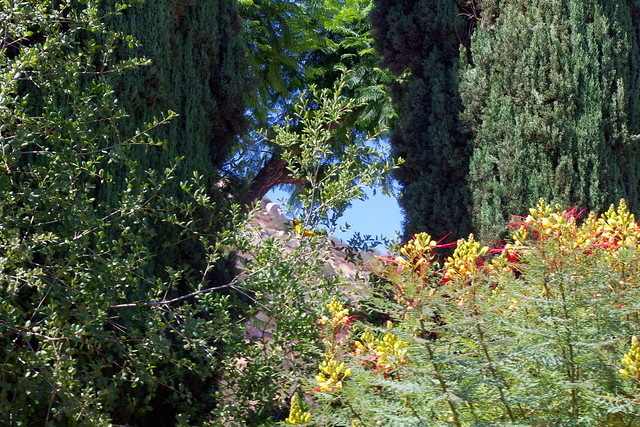 |
| Photo Credit: Mine |
Unfortunately I don't have a zoom lens on my camera and the fact that I even got this shot was a piece of luck. This is a Hooded Oriole (Icterus cucullatus) which you can see at the center of the photo in the Coast Live Oak branch above the full bloom of the Bird of Paradise Bush (Caesalpinia gilliesii) which I previously wrote about a few weeks back Here. I often would sit in the afternoon sun enjoying the afternoon warmth, when I'd here this distinctive chirp sound, only to see this bright deeply yellow/orange coloured bird feeding off the nectar of the Bird of Paradise Bush flowers which are now in full bloom.
 |
| Credit: (IBC) The Internet Bird Collection |
These birds literally love nectar and you will often see them at Hummingbird feeders trying to find a way for a quick sip. There actually are Oriole bird feeders which have larger beak openings for the Orioles, but landscaping with the right plants will attract them also. They are so timid and shy, so photographing is more of a challenge without zoom lens.
 |
| Photo Credit: Mine |
My Mum's Pozo Blue Sage which is in full bloom now and it's very aromatic fragrance permeates the entire front yard is also attracting numerous Bees like the Honeybee seen here. Although I don't have a picture of them, every so often 4 or 5 large black carpenter bees would show up all at once. I'd usually see them when I was leaving or on my way somewhere else in the Bronco I was driving while there on my visit. A cute little hummingbird was always present as well, but that was until my niece's little black cat caught it and brought it to the front door. The cat previously was bringing large grasshoppers to the front door. Over here in Sweden, many with outdoor cats have a bell attached to their collar to alert the birds.
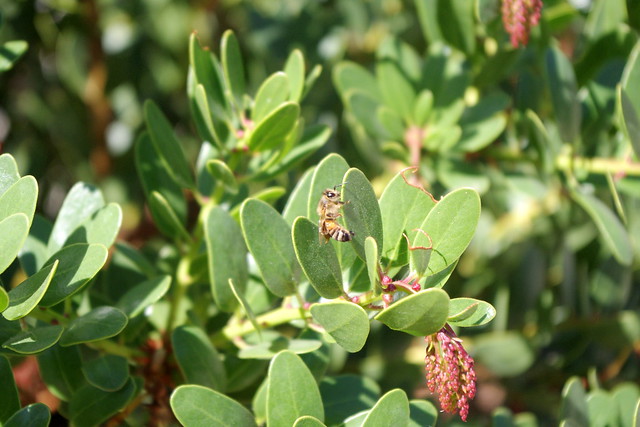 |
| Photo Credit: Mine |
This is my Mum's Island Manzanita I wrote about here "Canyon Sparkles" Island Manzanita when I first came to visit. It is beautiful, but I've been disappointed that it had not yet bloomed while on my visit. As you can see, there are unopened bloom clusters ready and willing, but perhaps the time is not right. Admittedly, it did have one bloom cluster with two petite looking Chinese Lantern flowers, but that was it. Should have stayed longer - *smile*Finally there were the small grove of California Sycamore woodland setting I created back in 2005. The previous plant residents behind the house were Fruitless Mulberry and Texas Umbrella or China Berry tree. Both needed to come out. The China Berry was extremely messy and weal brittle branches began falling during strong windy storms. The Fruitless Mulberry was also messy, but also had trunk and branch rot from improper pruning by my father. Below is the photo from back then and the updated background photo as the back area appears today with the California Sycamores, Canary Island pines, Tecate Cypress and Torrey Pine. Most of Southern California on this last visit has been a huge disappointment for me as far as the public's lack of interest in landscaping and the horrible example of it's Municipal, County, State and Federal leadership. I have no faith that this will ever change anytime soon. Anyway, below is some of the transformation with regards creating a microclimate of sorts for plants that cannot take full sun. So-Cal is so lucky as to have a climate that can be used for any plant theme concept. Pity that most don't realize it.
 |
| Photo Credit: Mine |
This was taken in January 2005 when my wife and kids came for a visit. Notice the Texas Umbrella tree on the left and the Fruitless Mulberry on the right just behind the roof line of view.
 |
| Photo Credit: Mine |
This photo is actually taken in the backyard in August 2007 where you can see the progress of the California Sycamore woodland. This was taken also during the finishing up of the cobblestone pathway which was the final blow to my knees. Should have worn pads. I've done lots of stone steps and brick or cobblestone pathways in the Landscape business. The trees at this point are 2 1/2 years old, but the grass is no longer there and has been replaced by bark mulch layer with native under story plants like Snow Pea, Chaparral Currant, Fuchsia Flowering Gooseberry and California Coffeeberry. Tecate Cypress is to the left in this picture and the exact spot where I'm standing is over a small Torrey Pine which is so large now (20') that taking this same photo angle would be just about impossible. I have a strategy for establishing such a plant community rapidly in both the urban landscape and habitat restoration in the wild and then allowing Nature to run it's course and it has to do with observations I've made over the decades about Bajadas or Alluvial Fans in Southern California mountain foothill regions. I've revisited some of these places on my last trip and I'll share them with everyone next week. Trust me, it's worked for me every time.
 |
| Photo Credit: Mine |
This was taken on our visit back in May 2011. Notice the roof line and the California Sycamores woodland along with the Canary Island Pines. The Canary Island pines were never planned, but volunteered from the mulch I had brought over from work just a year before I left for Sweden. Below, this is how things appear as of a couple weeks back at the time of this writing April 2013. I'll later post some pics I have of the California Sycamore plants under story which in itself replicates unique plant communities which exist under many Oak woodlands in California. The exciting thing is that such plant community establishments under Sycamores or Oaks are actually wildlife magnets which makes the whole gardening/landscaping game worth it if done properly.
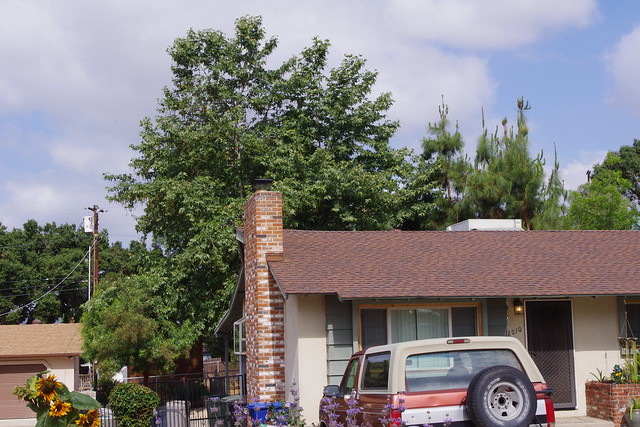 |
| Photo Credit: Mine |
I can't wait to see how it all turns out. Isn't it exciting!!!? Congrats on the nesting Black Phoebe. This is an adorable little bird. Hope all is well.
ReplyDeleteYes, I had never seen the Black Phoebe nest before , so it was exciting. I cleaned the berries off the Island Manzanita hoping for a quicker bloom. When I least expected it and without my camera, a Mockingbird came out of nowhere and proceeded to gobble up all green berries. Go figure.
Delete-
I would LOVE to have some kind of oak in our desert yard...do you know a species which can survive the desert heat?
ReplyDeleteYrs I do, that would be Engelmann Oak (Quercus engelmannii)I'm not sure if you read my account of this oak, but I've taken more pics and will write about it some more. I went on a hike in the San Felipe Valley near Scissors Crossing on the western edge of Anza Borrego Stat Park. We were investigating a Cal-Forestry Control Burn which got out of control and destroyed 6 large specimens near the valley floor along the foot hills. Evidence indicates that they were once extensive throughout the Mojave Desert clear into Arizona. Here's the link to that post of mine.
DeleteEngelmann Oak (Quercus engelmannii) an Often Ignored Native in the Landscape
But don't ever plant it without inoculation with great mycorrhizal blended fungi and bacterial species mix. Pisolithus Tinctorius Mycorrhizae (The Dog Turd Fungus) will be foremost among all of these. I posted something on this below with regards Pecan Trees which would do exceptionally well in the desert. There are several massive Pecan plantations halfway between Phoenix & Tucson. I also mentioned the brand of mix and where to purchase it.
Pecan Tree Volunteer Soaring High Wonderfully Skyward, Thanks to Mycorrhizal Applications
-
Nice observations. The Black Phoebes have never made a home on OUR home yet (they're actually not common at our 4200 foot elevation here). I love Las Pilitas Nursery, by the way. A regular destination for decorative plants for us (I bought a Clevelend Sage and Mimulus there this spring).
ReplyDeleteYes, I do most of my plant purchases from Las Pilitas Nursery. In the early days, when I was close by, Tree of Life Nursery was my choice.
DeleteI have been there twice on my trip and planted several Engelmann Oak and Digger Pine at my brother's place in Ranchita